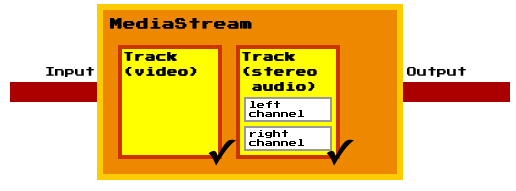
getusermedia: Getting access to local devices that can generate multimedia streams
W3C Editor's Draft 27 April 2012
- This version:
- http://dev.w3.org/2011/webrtc/editor/getusermedia-20120427.html
- Latest published version:
- http://www.w3.org/TR/getusermedia/
- Latest editor's draft:
- http://dev.w3.org/2011/webrtc/editor/getusermedia.html
- Previous version:
- http://dev.w3.org/2011/webrtc/editor/getusermedia-20111222.html
- Editors:
- Daniel C. Burnett, Voxeo
- Anant Narayanan, Mozilla
Initial Author of this Specification was Ian Hickson, Google Inc., with the following copyright statement:
© Copyright 2004-2011 Apple Computer, Inc., Mozilla Foundation, and Opera Software ASA. You are granted a license to use, reproduce and create derivative works of this document.
All subsequent changes since 26 July 2011 done by the W3C WebRTC Working Group are under the following Copyright:
© 2011 W3C® (MIT, ERCIM, Keio), All Rights Reserved. Document use rules apply.
For the entire publication on the W3C site the liability and trademark rules apply.
Status of This Document
This section describes the status of this document at the time of its publication. Other documents may supersede this document. A list of current W3C publications and the latest revision of this technical report can be found in the W3C technical reports index at http://www.w3.org/TR/.
This document is not complete. It is subject to major changes and, while
early experimentations are encouraged, it is therefore not intended for
implementation. The API is based on preliminary work done in the WHATWG.
The Media Capture Task Force expects this specification to evolve
significantly based on:
- Privacy issues that arise when exposing local capabilities and local
streams.
- Technical discussions within the task force.
- Experience gained through early experimentations.
- Feedback received from other groups and individuals.
This document was published by the Media Capture TF as an Editor's Draft. If you wish to make comments regarding this document, please send them to public-media-capture@w3.org (subscribe, archives). All feedback is welcome.
Publication as an Editor's Draft does not imply endorsement by the W3C Membership. This is a draft document and may be updated, replaced or obsoleted by other documents at any time. It is inappropriate to cite this document as other than work in progress.
This document was produced by a group operating under the 5 February 2004 W3C Patent Policy. W3C maintains a public list of any patent disclosures made in connection with the deliverables of the group; that page also includes instructions for disclosing a patent. An individual who has actual knowledge of a patent which the individual believes contains Essential Claim(s) must disclose the information in accordance with section 6 of the W3C Patent Policy.
2. Stream API
2.1 Introduction
The MediaStreamMediaStream
Each MediaStream
Each track in a MediaStream object has a corresponding
MediaStreamTrack
A MediaStreamTrack
A channel is the smallest unit considered in this API
specification.
A MediaStreamLocalMediaStreamgetUserMedia()
call (which is described later in this
document), for instance, might take its input from the user’s local
camera. The output of the object controls how the object is used, e.g.
what is saved if the object is written to a file, what is displayed if
the object is used in a video element
Each track in a MediaStream
A MediaStream
The output of a MediaStream
A new MediaStreamMediaStreamTrackMediaStream() constructor.
The constructor takes two lists of MediaStreamTrackMediaStreamTrackMediaStream

The ability to duplicate a MediaStreamMediaStreamMediaStream
The LocalMediaStream
When a LocalMediaStreamMediaStream object is also used in contexts outside
getUserMedia, such as [WEBRTC10]. Hence ensuring a
realtime stream in both cases, reduces the ease with which pages can
distinguish live video from pre-recorded video, which can help protect
the user’s privacy.
2.5 URL
partial interface URL {
static DOMString createObjectURL (MediaStream stream);
};
2.5.1 Methods
createObjectURL-
Mints a Blob URL to refer to the given
MediaStream
When the createObjectURL() method
is called with a MediaStreamMediaStream
For audio and video streams, the data exposed on that stream must
be in a format supported by the user agent for use in
audio and video elements.
A Blob URL is the
same as what the File API specification calls a Blob URI, except that
anything in the definition of that feature that refers to
File and Blob objects is hereby extended to
also apply to MediaStreamLocalMediaStream
| Parameter | Type | Nullable | Optional | Description |
|---|
| stream | MediaStream | ✘ | ✘ | |
3. Obtaining local multimedia content
4. Examples
This sample code exposes a button. When clicked, the button is
disabled and the user is prompted to offer a stream. The user can cause
the button to be re-enabled by providing a stream (e.g. giving the page
access to the local camera) and then disabling the stream (e.g. revoking
that access).
<input type="button" value="Start" onclick="start()" id="startBtn">
<script>
var startBtn = document.getElementById('startBtn');
function start() {
navigator.getUserMedia({audio:true, video:true}, gotStream);
startBtn.disabled = true;
}
function gotStream(stream) {
stream.onended = function () {
startBtn.disabled = false;
}
}
</script>
This example allows people to take photos of themselves from the local
video camera.
<article>
<style scoped>
video { transform: scaleX(-1); }
p { text-align: center; }
</style>
<h1>Snapshot Kiosk</h1>
<section id="splash">
<p id="errorMessage">Loading...</p>
</section>
<section id="app" hidden>
<p><video id="monitor" autoplay></video> <canvas id="photo"></canvas>
<p><input type=button value="📷" onclick="snapshot()">
</section>
<script>
navigator.getUserMedia({video:true}, gotStream, noStream);
var video = document.getElementById('monitor');
var canvas = document.getElementById('photo');
function gotStream(stream) {
video.src = URL.createObjectURL(stream);
video.onerror = function () {
stream.stop();
};
stream.onended = noStream;
video.onloadedmetadata = function () {
canvas.width = video.videoWidth;
canvas.height = video.videoHeight;
document.getElementById('splash').hidden = true;
document.getElementById('app').hidden = false;
};
}
function noStream() {
document.getElementById('errorMessage').textContent = 'No camera available.';
}
function snapshot() {
canvas.getContext('2d').drawImage(video, 0, 0);
}
</script>
</article>
